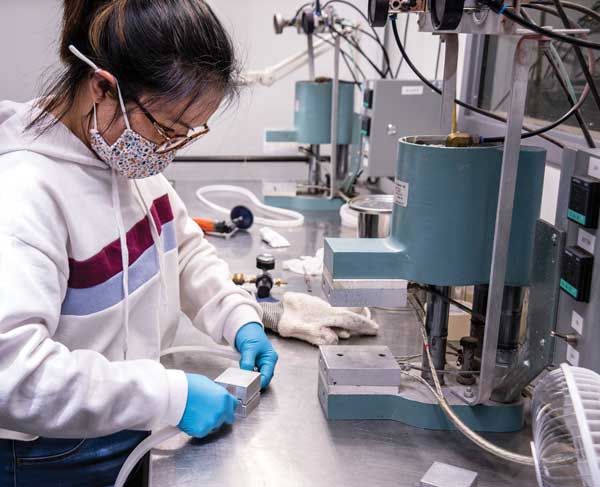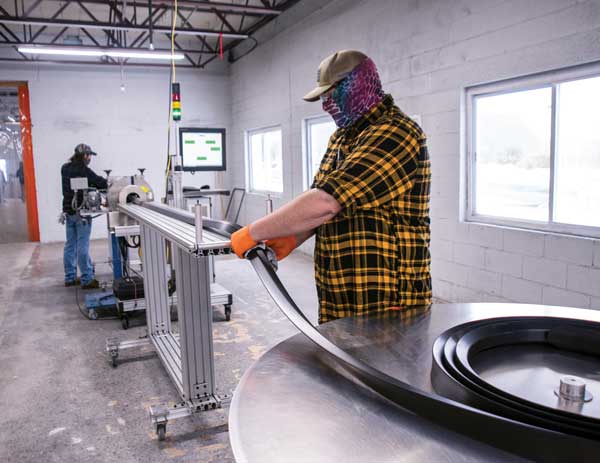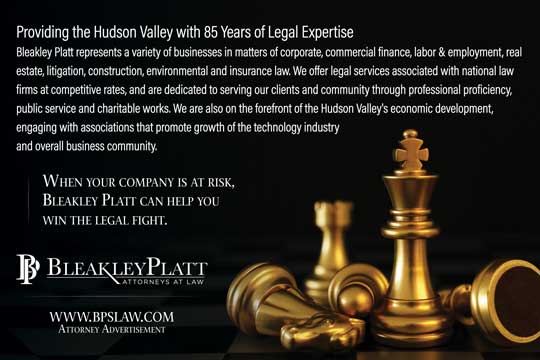LEADER PROFILE
Craig Busby and John Rickert, Co-CEOs of Pawling Engineered Products
IS CEO A TWO-PERSON JOB?

It is rare for any organization to have co-leaders, and even more rare for a manufacturing business to employ the strategy. It is easy to envision where pre-determined boundaries might blur, where conflicts could arise, and decision-making stall. Salesforce.com, SAP, and Oracle had all abandoned Co-CEO structures within the last year, though Netflix announced this summer that it was elevating chief content officer Ted Sarandos to Co-CEO, sharing the title with founder Reed Hastings.
In an article in the Harvard Business Review from last September, however, John Gerzema and Will Johnson posed the question: “is CEO a two-person job?” Their conclusion is “it can be.” Our conclusion, after a wide-ranging interview with Pawling Engineered Products Co-CEOs (and brothers-in-law) Craig Busby and John Rickert, is a resounding yes.
HV Mfg: This is our first time interviewing Co-CEOs and we are looking forward to it. Let’s start with some background: how did you come to work in manufacturing?
JR: I grew up on Long Island and when I graduated from high school, I went to Carnegie Mellon University, where I received a degree in industrial management. I started out by taking a few courses related to production and manufacturing and it resonated with me. The owner of a printing company located over in Danbury was on CMU’s advisory board for a relatively new program that focused on printing, so I ended up interning with them for two summers and then working for them full time when I graduated.
HV Mfg: CMU—that is impressive—how did you end up there and how did you end up here at Pawling Engineered Products?
JR: I wasn’t sure where I wanted to go to college. I was a pretty good student, but I didn’t really know what I wanted to study. My guidance counselor recommended CMU partly because it offered a variety of options in terms of what I could study. It was a bit of a stretch for me to get in, so I applied early decision and ended up being accepted, which ended up working out great. I really enjoyed my experience there. It was tough, but I certainly learned a lot. As for ending up in Pawling, I married Craig’s sister, Andy, in 1996 and given my background in manufacturing, it seemed like a natural fit for me to join the family business. It was Craig’s uncle, Roger Smith, who brought me in and mentored me. Shortly after I joined the company, I found myself in charge of the Custom Mixing Division, which mixed about 20 million pounds of compound a year. I was only about 31 at the time, so it was a lot of responsibility for someone that age, but Roger spent a lot of time mentoring me and teaching me about the business. I certainly couldn’t have done it without him.
HV Mfg: Craig, this is your family’s business—did you always know you would end up here?
CB: No, not really. I was certainly familiar with the business. My dad and uncles worked here but I was the sixth of 11 grandchildren and none of the older ones had entered the business. I grew up in Pawling, and then studied geology and history at Colgate. After college, I became a teacher at Trinity-Pawling, and did that for a bit. That was a fabulous experience; I learned a lot about public speaking, presenting, and communicating. When I was younger, I did go on a number of customer calls with my dad, who was in charge of sales and marketing, but really never thought it would be a career for me. After T-P, however, I thought I should give the family business a chance and, like John, it was my Uncle Roger who mentored me. He encouraged me and then cobbled together a leadership training program for me. I spent two years working in all of the company’s divisions, learning all aspects of the business.
HV Mfg: This is before the company split in two, correct? Maybe you can put on your teacher hat and give us a quick history lesson?
CB: Sure. The original company was founded by my great uncle, Smith Johnson, who, with his father (my great grandfather) had started Johnson Rubber in Middlefield, Ohio. Smith was a classic entrepreneur and master “tinkerer”. To this day, we still use the equipment he designed and built. The company first started as a division of Johnson Rubber, then spun off into its own company which was called Pawling Rubber. My grandfather eventually joined the company and took over as President. In the beginning, we manufactured compression seals for military ammunition cases and household appliances. Remember when coffee makers were made in the US? Then, as the business grew, it became more vertically integrated. We began mixing our own rubber and added several product lines, such as floor matting and wall protection systems. A few years later, the company acquired Presray Corporation, a company that made highly technical lifting devices that used inflatable rubber seals. We started selling these inflatable seals into other industries, such as nuclear power, food processing, and powder bulk manufacturing equipment.
After my grandfather retired, my father, Bob, and his brother-in-laws, Roger and Stephen, grew the business to nearly $60 million in annual sales by the late 1990s with close to 400 employees. Almost 10 years ago, we split into two separate companies. My cousin Jason runs Pawling Corporation. They are now located a few miles up the street in Wassaic. Our business is Pawling Engineered Products, and we are still located in Pawling.

HV Mfg: And what do you make here?
JR: We make specialty rubber and plastic products—inflatable and compression seals, gaskets, clamps and other items for applications in nuclear energy, aerospace, defense, life sciences, food processing, bio-tech—a wide range of industries.
HV Mfg: Can you give us a few examples of the products and how they are used? Where might we use or see them?
JR: Any time an industry needs a tight seal or to hold something securely in place, our products can be used. A simple example is in the nuclear power industry. Our seals are used on large airlock doors to seal out the radiation in nuclear power plants. We make about 10 to 20 of these seals per year, so the volume isn’t high but there is a high degree of customization. We also began working with a large tier one supplier in aerospace, who makes composite fuselage sections. Our product is called a “stringer bladder” and is used as part of the manufacturing tooling for these large structures. Some of these parts are over 60 feet long with extremely tight tolerances.
HV Mfg: Are these standard product lines or customized?
CB: It’s a little bit of both. Much of what we do centers around a “mass customization” model. We have base product lines that can be customized to meet the customer requirements without the need for tooling. We work with them to help them understand what they need as well as what is possible.
HV Mfg: How has the pandemic affected your business?
JR: We were definitely affected negatively. The aerospace industry got hit hard and they are a significant portion of our business. That sector was off about 50%, but we are highly diversified and other sectors have picked up a good amount of that slack.
CB: We also have a strong relationship with our customers. For some, it was my father who originally developed the account over 20 years ago. Currently, our sales team does a great job of making sure our customers are well taken care of. They have a lot of experience and continue to build and maintain strong relationships. Those relationships have definitely helped as we have navigated the past 12 months or so.
JR: I would add that all of our team here have been tremendous. We were an essential business and remained open. Many people who were able to do their jobs remotely did so, but most of us came to work and worked safely. We implemented social distancing rules and procedures, required mask wearing and figured out a way to safely get our product out the door. For those of us working on site, we went to a split-shift arrangement in order to minimize some of the risk of exposure. The early shift came in at 4:00 a.m. and worked until noon. Then, we made sure everyone left the property before the afternoon shift arrived at 12:30 p.m. and then they worked until 8:30 p.m. It was a lot to ask, but everyone was really terrific about making the adjustment.
Craig and I are really proud of how the team pulled together and did what was needed to get the job done during this tough time.

HV Mfg: Co-CEOs: it’s not very common. How does it work?
CB: It works great.
JR: I agree it does work great, it’s smooth, seamless.
CB: We have divided our responsibilities pretty evenly and focus on each of our strengths and interests. I work primarily on the sales, marketing, and new product development — the “outside” stuff. John works primarily on the operations side or “inside” stuff. He excels and really enjoys working with the production team, building and improving systems. I like the customer-facing side of things.
HV Mfg: There must be times when a conflict arises, perhaps a disagreement on strategy or investment?
CB: Not really, no. We are very much on the same page as to the direction of the company and how to get there. I also think—and maybe this is because we are brothers-in-law and friends—that we are constantly communicating and know each other’s minds.
JR: I agree. We each have pretty wide latitude to work in our designated areas. We trust each other. If there ever is a time when one of us thinks what the other is doing is a really bad idea, if we feel strongly about that, then we won’t do it. It is a form of consensus, I guess.
HV Mfg: Thinking about the next two to three years, what are some of the opportunities for the company and what are the challenges?
CB: I think the opportunities lie in the aerospace side of the business and continuing to bolster our engineering and operational capabilities. From 2017 to 2020, aerospace was growing rapidly, and while COVID hit it hard, we anticipate it recovering in 2022. We want to be ready when it comes back.
JR: We do see that business returning and it will present opportunities when it does. We want to be ready. As far as challenges go, it is attracting and retaining talent. On the one hand, we require some pretty unique skills, while on the other, we really need reliable, interested and engaged people. When we find a person like that, we work hard to train them and keep them.
CB: Along those lines, we are concerned about succession in key positions. I think it will be important to transfer any “tribal” knowledge they have to the next generation. I think that is true for our entire organization.

HV Mfg: How would you describe your leadership styles?
JR: I try to lead by example. I think it is important to set a good example and “walk the walk.” I have a tremendous amount of respect for all of the people who work here, and I wouldn’t ask any of them to do anything I wouldn’t do myself. During some of the busier times, like the end of a shipping period, I try to go out onto the floor and help with some of the simpler tasks like finishing seals, making boxes, packaging parts and bringing them to shipping, things like that. When COVID hit and we needed to get product to our customers, Craig and I both spent a lot of time on the floor helping out. We always made sure we were wearing a face covering—again, not asking our team to do something we are not prepared to do ourselves. We have 137 people who work here and a friend of mine was surprised that I know everyone by name. To me it would be surprising not to. I interact with just about everyone on our team weekly if not daily. How could I not know their names?
CB: John said it. My father and uncles set a good example in how they treated the employees, each other, their work ethic, and the legacy they left. They left us this company and the opportunities and responsibilities that go with it. I take that seriously and it is a big part of everything we do. I think that is one reason for our success. We have a company that feels more like a family—at least we try to make it feel that way. I’m sure some management consultants would say that we are too “in the weeds,” but for me, for us, that is the type of company we want to have.
HV Mfg: Do you have any leaders from history or industry that you admire or try to emulate? Maybe even someone you worked with?
JR: Well, since you included someone you worked with, I have to say Roger (Smith). I really always admired his intelligence, his demeanor, his ability to think strategically. He brought me into the business and made feel like a part of it. He gave me tremendous responsibilities as a young man, and he gave me enough room to learn but not to fail.
CB: I would have to say both my dad and Roger. My dad was a great example and taught me a lot about sales that is integral to what I do every day. My Uncle Roger was everything John said, and I will add just a great person—smart, funny, and kind.
Another figure—and maybe it’s a bit obvious—but I have always admired Abraham Lincoln. Especially given the division in the nation today, his strength and courage, perseverance and wisdom through the Civil War years has always inspired me.
HV Mfg: We too had the privilege of knowing and working with Roger and fully understand your admiration of him.
HV Mfg: This company has been a member of the Council of Industry for the better part of 60 years. What programs or services do you find the most valuable?
CB: First, let me say how valuable the information you have been providing us since the pandemic hit last year. Things were moving pretty quickly, and we always felt informed and up-to-date thanks to the Council. We also appreciate the wage and benefits data, the training and just knowing there is a group of like-minded people out there who understand our business and our challenges. That brings us plenty of value.
JR: I think the training is important and the connection to other manufacturers in the region as well. I also appreciate all the workforce development the Council is doing, including the apprentice program.
HV Mfg: Thank you both for your time. We hope you are proud of all you are accomplishing here.
JR: Thank you.
CB: Thank you, and thank you for the opportunity.



